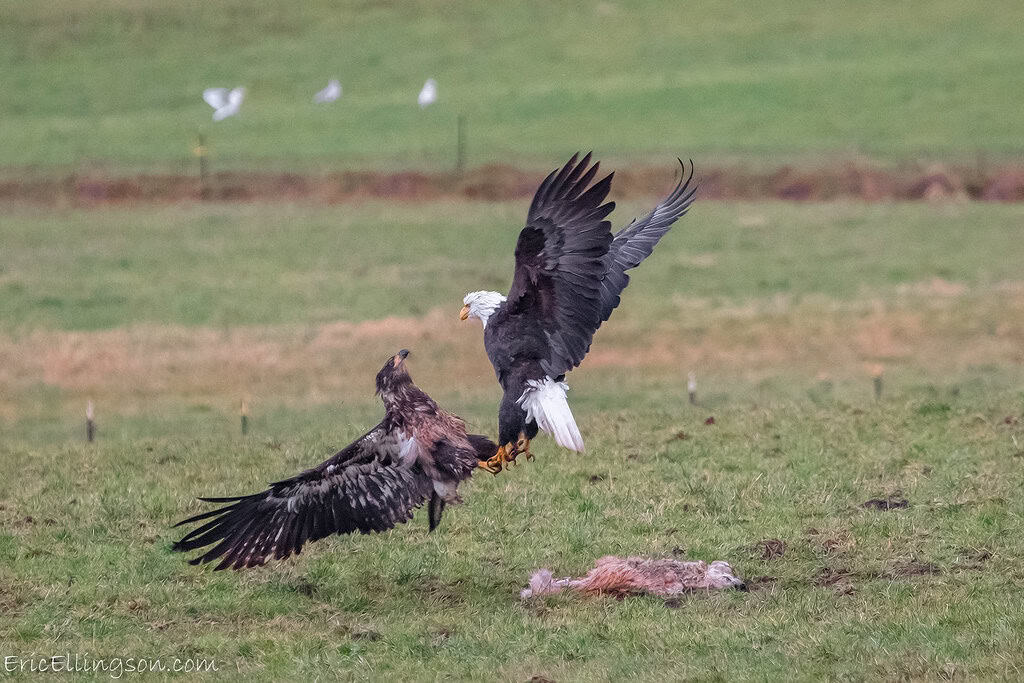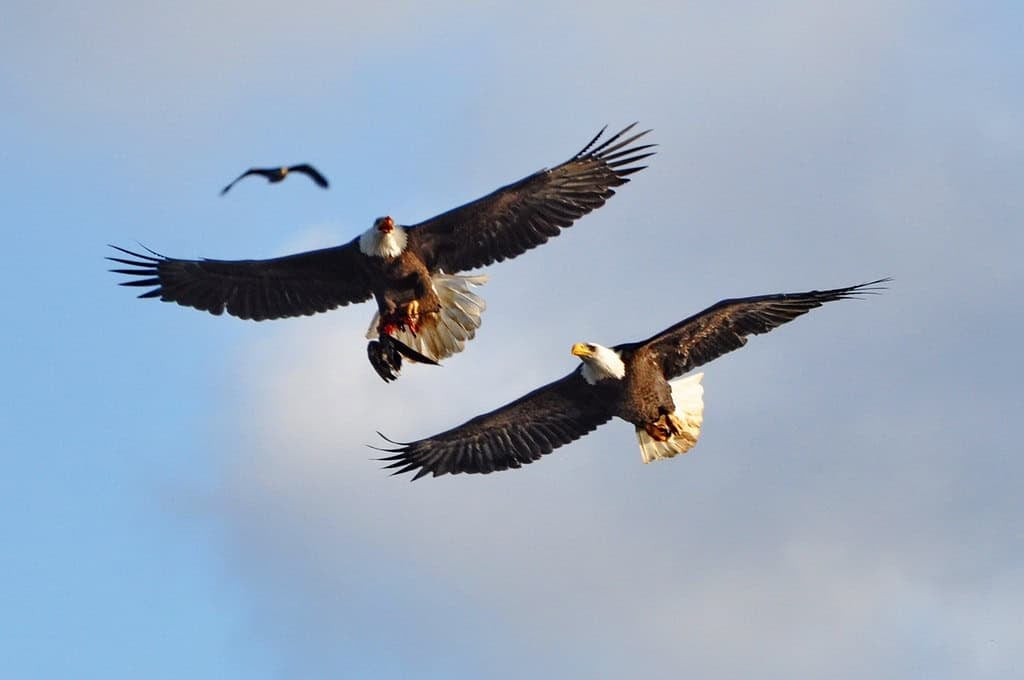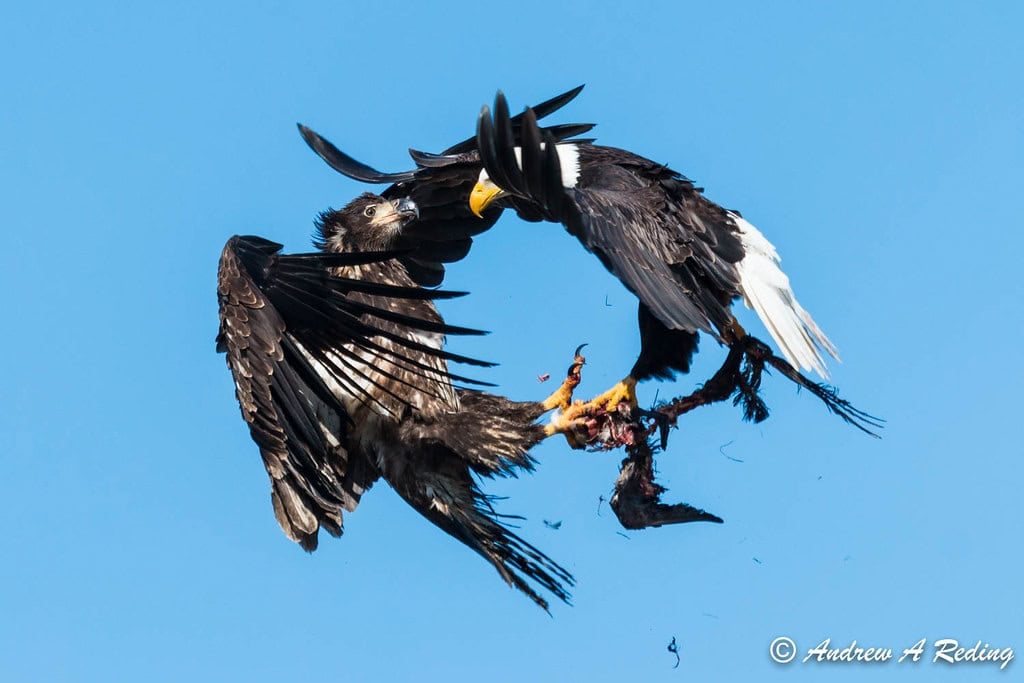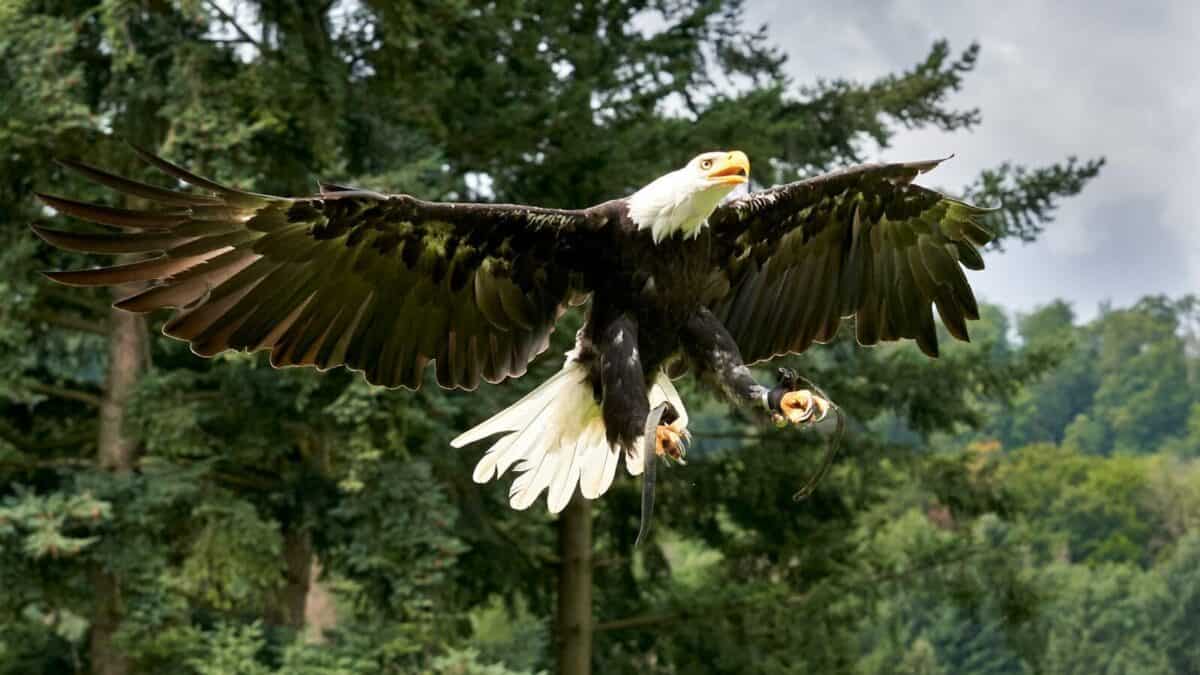The bald eagle (Haliaeetus leucocephalus), America’s national symbol, is not just majestic in appearance but fiercely territorial in nature. These impressive raptors establish and defend specific geographic areas that provide them with essential resources: nesting sites, hunting grounds, and perching locations. A typical bald eagle territory can span anywhere from 1 to 2 square miles, though this varies based on habitat quality and food availability. The more productive the ecosystem, the smaller the territory needs to be.
For bald eagles, territorial defense isn’t just about maintaining personal space—it’s critical for survival and reproductive success. These birds mate for life and often return to the same territory year after year, investing significant energy in protecting these carefully selected areas. Understanding how these magnificent birds defend their territories—and which strategies sometimes fail—offers fascinating insights into their behavior and ecological adaptations. Let’s explore the effective defensive tactics bald eagles employ and examine why certain approaches don’t always succeed.
Successful Strategy #1 Impressive Aerial Displays

One of the most spectacular ways bald eagles defend their territory is through dramatic aerial displays. These visual demonstrations serve as a first warning to potential intruders and are often effective in deterring them without physical confrontation. The defending eagle will soar to great heights, sometimes exceeding 3,000 feet, before performing a series of swooping dives, rolls, and acrobatic maneuvers. During these displays, eagles may reach speeds of up to 100 mph, creating an impressive and intimidating spectacle.
These aerial performances aren’t just random movements—they’re carefully calculated to showcase the eagle’s strength, agility, and command of the airspace above their territory. Mated pairs often participate together in these displays, reinforcing their bond while doubling the intimidation factor for any would-be intruders. The sight of two adult bald eagles performing synchronized aerial maneuvers effectively communicates to other eagles that the territory is occupied by a strong, capable pair ready to defend their claim.
Successful Strategy #2 Vocalizing Territorial Claims

Bald eagles are known for their distinctive vocalizations, which play a crucial role in territory defense. Their high-pitched, chirping whistles might seem surprisingly delicate for such large birds, but these calls carry over long distances and serve as clear acoustic boundaries. Scientists have identified at least three distinct calls used in territorial contexts: the “peal call” (a series of high-pitched, staccato notes), the “chatter call” (rapid succession of short notes), and the “kwit call” (sharp, single notes used in immediate threat situations).
Eagle pairs often coordinate their vocalizations, creating duets that strengthen their territorial message. Research has shown that these calls contain individual-specific characteristics, allowing eagles to recognize particular neighbors versus unknown intruders. This vocal recognition system is sophisticated enough that established territorial neighbors may respond less aggressively to familiar calls from adjacent territory holders compared to the vocalizations of strange eagles. This “dear enemy” recognition helps reduce unnecessary energy expenditure while maintaining strong boundaries against unknown challengers.
Successful Strategy #3 Strategic Perching and Vigilance

Bald eagles maintain vigilant watch over their territories from carefully selected perching locations. These strategic observation posts typically include tall trees with open sight lines that offer panoramic views of their domain. Eagles will spend hours perched in these locations, scanning for both potential prey and territorial intruders. A study in the Chesapeake Bay region found that territorial eagles spend up to 70% of daylight hours engaged in this vigilant perching behavior during breeding season.
The effectiveness of this strategy lies in its psychological impact—the mere presence of a resident adult eagle visibly perched in a commanding position often deters potential challengers. These perches are typically positioned along the perimeter of their territory, creating a visual boundary line. Eagles rotate between several favorite perches throughout the day, ensuring maximum coverage of their territory. This constant vigilance, while seemingly passive, serves as a continuous visual reminder to other eagles that the territory is actively occupied and defended.
Successful Strategy #4 Physical Confrontation and Talon Grappling

When visual displays and vocalizations fail to deter intruders, bald eagles resort to direct physical confrontation. These encounters can be dramatic and potentially dangerous for both birds involved. The defending eagle will typically approach the intruder with legs extended forward, showcasing their powerful talons. If the intruder doesn’t retreat, the eagles may engage in “talon grappling”—a behavior where they lock talons in mid-air and spiral toward the ground in a dangerous aerial dance that tests strength and resolve.
These physical confrontations rarely result in serious injury or death, as they typically end when one eagle acknowledges defeat and retreats. However, the potential consequences are severe enough that most territorial disputes don’t escalate to this level. Researchers have documented that established territory holders win approximately 85% of these confrontations, demonstrating the significant advantage that comes with defending familiar ground. The physical risk involved makes this strategy a last resort, employed only when other defensive measures have failed to resolve the territorial dispute.
Successful Strategy #5 Cooperative Defense Between Mates

Bald eagles form monogamous pairs that typically mate for life, and this partnership extends to territorial defense. Mated pairs engage in coordinated defense strategies that significantly enhance their effectiveness. While one eagle might patrol the perimeter of their territory, the other remains close to the nest, especially during breeding season. This division of labor ensures complete coverage of their domain while protecting their most valuable asset—their offspring.
The coordination between mates can be remarkably sophisticated. Eagles have been observed executing pincer movements against intruders, with each mate approaching from different directions to confuse and overwhelm the challenger. This cooperative approach makes the territory appear more thoroughly defended than it might be with just a single bird. Studies indicate that territories defended by established pairs are invaded less frequently than those held by single eagles, demonstrating the effectiveness of this partnership strategy in territorial maintenance.
Successful Strategy #6 Nest Maintenance as Territorial Signaling

Bald eagles build some of the largest nests of any North American bird, with structures that can reach 6 feet in diameter, 6 feet in depth, and weigh up to 2 tons after years of additions. Beyond their practical purpose for raising young, these massive nests serve as conspicuous territorial markers. Eagles actively maintain and enhance their nests throughout the year, not just during breeding season. This continuous construction activity signals ongoing occupation and investment in the territory to potential challengers.
The size and condition of the nest also communicate valuable information about the fitness and resource-holding potential of the resident pair. A well-maintained, substantial nest indicates successful, experienced eagles capable of defending their territory. Research has shown that territories with prominent, well-maintained nests experience fewer intrusion attempts than comparable territories where nests are less visible or in poorer condition. Through this impressive architectural display, eagles establish a powerful visual claim to their chosen territory that complements their other defensive strategies.
Failed Strategy #1: Defending Too Large a Territory

While bald eagles are formidable territorial defenders, they sometimes overextend themselves by attempting to claim more area than they can effectively control. This typically occurs in regions with abundant resources where the temptation to monopolize prime hunting grounds leads eagles to expand their boundaries beyond sustainable limits. A single pair simply cannot maintain consistent surveillance over an oversized territory, leaving gaps in their defensive perimeter that rivals quickly exploit.
Research in the Pacific Northwest demonstrated that eagles attempting to defend territories larger than 3 square miles experienced significantly higher rates of territorial intrusion and were more likely to lose portions of their claimed area over time. The energy expenditure required to patrol and defend an oversized territory also reduces resources available for hunting and reproduction, creating a downward spiral where defensive capability progressively diminishes. Successful eagle pairs typically maintain territories properly scaled to their defensive capabilities, recognizing that effective defense of a modest territory is preferable to ineffective claims over a larger area.
Failed Strategy #2: Inconsistent Territorial Presence

Bald eagles that fail to maintain a consistent presence within their territory often find their boundaries increasingly violated by opportunistic rivals. This problem commonly arises when eagles spend too much time pursuing prey far from their core territory or when they’re distracted by abundant but temporary food sources elsewhere. The territorial defense maxim of “use it or lose it” applies strongly to bald eagles, with unattended territories quickly becoming targets for takeover attempts.
This vulnerability is particularly evident during non-breeding seasons when the motivation to defend may naturally decrease. A study tracking eagle movements in Florida found that territories left unattended for more than three consecutive days experienced a 60% increase in intrusion attempts. Once intrusions begin regularly, reestablishing exclusive control becomes increasingly difficult. Successful territory holders counter this risk by ensuring at least one member of the pair remains within visual range of their core territory, even when food resources might temporarily be more abundant elsewhere.
Failed Strategy #3: Failure to Adapt to Changing Circumstances

The final unsuccessful defense strategy involves eagles failing to adapt their territorial behavior to changing environmental or social conditions. For example, eagles that maintain rigid territorial boundaries regardless of seasonal fluctuations in food availability may exhaust themselves defending areas that temporarily hold little value. Similarly, eagles that don’t adjust their defensive intensity based on the specific threat posed by different intruders (neighboring pairs versus floater eagles seeking territory) waste valuable energy on unnecessary confrontations.
Eagles that successfully maintain territories over many years demonstrate remarkable adaptability, expanding or contracting their claimed area based on resource availability and adjusting their defensive tactics to match specific challenges. Research comparing long-term territory holders with eagles that frequently lose territories shows that adaptive flexibility is a key differentiator. The rigid defenders that fail to modify their approach based on changing circumstances typically experience shorter tenures in their territories. This inflexibility represents perhaps the most fundamental failure in territorial defense strategy, undermining otherwise effective defensive behaviors.
Understanding the Evolutionary Significance of Eagle Territories

The territorial behaviors of bald eagles represent millions of years of evolutionary refinement, balancing the costs of defense against the benefits of exclusive resource access. Each successful defensive strategy has been shaped by natural selection to maximize reproductive success while minimizing unnecessary energy expenditure or physical risk. The sophisticated nature of these behaviors—from coordinated defense between mates to the dear enemy recognition system—highlights the remarkable cognitive capabilities of these birds.
Even the failed strategies provide important evolutionary insights, as they demonstrate the boundaries of effective territory maintenance and the consequences of defensive overreach. These limitations have helped shape the typical territory size and defensive behaviors we observe in modern eagle populations. Understanding both the successful and unsuccessful approaches to territory defense gives us a more complete picture of eagle behavior and the ecological pressures that have shaped these magnificent birds through countless generations.
Conservation Implications of Territorial Behavior

The territorial nature of bald eagles has significant implications for conservation efforts. As eagle populations recover from their endangered status, increasing competition for prime territories can lead to greater frequency and intensity of territorial disputes. Conservation managers must consider territorial requirements when estimating habitat carrying capacity and planning protected areas. A healthy eagle population needs sufficient high-quality territory options to accommodate breeding pairs without excessive competitive pressure.
Human disturbance can disrupt territorial behaviors and defense, potentially leading to territory abandonment or reduced reproductive success. Research has shown that eagles nesting in areas with heavy human activity may spend more energy on territorial defense and less on parental care. Conservation strategies that include buffer zones around active territories, particularly during breeding season, help mitigate these impacts. By understanding and accommodating the territorial needs of bald eagles, conservation efforts can better support the continued recovery of this iconic species throughout its range.
Conclusion: The Delicate Balance of Territorial Success

The territorial defense strategies employed by bald eagles represent a fascinating balance between aggressive protection and energy conservation. The most successful eagles utilize a progressive approach, starting with low-cost visual and vocal warnings before escalating to more energetically expensive and risky confrontations only when necessary. This balanced approach allows them to maintain their territories while preserving resources for other critical activities like hunting and reproduction.
Failed strategies typically involve either overcommitment of resources or insufficient investment in defense, highlighting how narrow the optimal range of territorial behavior truly is. Eagles must constantly evaluate and adjust their defensive efforts based on the specific context and threat level, demonstrating remarkable behavioral flexibility and decision-making capabilities.
For bald eagles, territory isn’t just about space—it represents security, reproductive opportunity, and sustained access to critical resources. The sophisticated strategies they’ve evolved to defend these areas have contributed significantly to their evolutionary success and recovery from endangered status.
As we continue to share landscapes with these magnificent birds, understanding their territorial needs and behaviors helps us better protect them and appreciate the complex social dynamics that unfold in the skies above us. The bald eagle’s territorial nature reveals not just the fierce determination symbolized in our national emblem, but also the strategic intelligence that has allowed these birds to thrive across North America’s diverse ecosystems.
- The 11 Endangered Species Bouncing Back Thanks to Conservation Efforts - August 20, 2025
- 13 Reasons Cheetah Populations Are Declining Fast - August 20, 2025
- 11 Mammals That Live in Water - August 20, 2025

